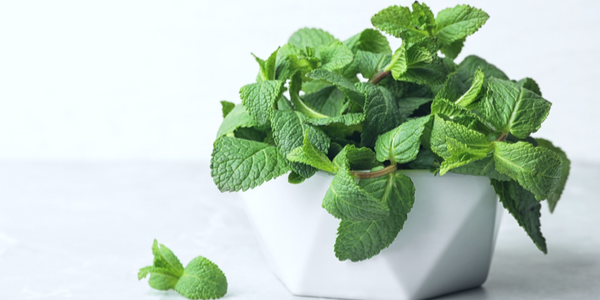
There are many health benefits of spices and herbs with mint being no exception. Dried or fresh, herbs and spices are a concentrated source of antioxidants and can help lower the risk for many chronic diseases.
Mint is a common flavor for toothpaste, gum, and mouthwash in the US. While not as popular for cooking as other herbs, adding mint to the diet not only adds a refreshing flavor but an array of health benefits.
Curious what mint has to offer and how it can be added to the diet? Read on to discover mint health benefits and creative ideas for what to do with mint leaves.
Peppermint vs Mint
Before diving into how to use mint and the benefits of mint leaves, there is some clarifying that needs to be done. Are peppermint and mint the same thing? They are often used interchangeably, but technically peppermint is a type of mint.
Mint encompasses a general term for all types of mint - most commonly spearmint in the US. Peppermint is actually a hybrid of spearmint and watermint. Peppermint has a higher amount of menthol compared to spearmint. Because of this, peppermint has a stronger mint flavor.
Martha Stewart suggests peppermint is usually used for tea and desserts. Spearmint is more likely paired with savory dishes, used in mojitos and other drinks. However, there are some differences of opinion and taste preferences. Many people can interchange spearmint (mint) with peppermint for any use.
If looking to experiment with mint flavors, look for other types of mint including chocolate, apple, orange, or pineapple. These types of mint may be available at local plant nurseries or farmers' markets.
What to Do With Mint Leaves
Whether from the garden or from a store, what can you do with mint leaves in the kitchen? The answer is there are many uses for mint.
Some easy but creative ways to add fresh mint leaves to the diet include the following:
• Chop mint leaves and add with sliced cucumber to add flavor to sparkling or plain water.
• Add a sprinkle of mint leaves to any smoothie for a refreshing mint flavor. Add an extra pop of mint with fresh mint leaves to this chocolate mint smoothie.
• Add minced mint leaves to fruit salads or to cubed watermelon for an unusual but delicious food combination.
• Use fresh or dried mint leaves to make your own homemade seasoning mix to be used for meats or roasted vegetables.
• Steep mint leaves with hot water for about 5 minutes. Option to add a squeeze of lemon and honey.
• Add chopped mint leaves with other leafy greens in salads, spring rolls, or grain-based salads.
• Use fresh mint leaves in a homemade green goddess dressing.
6 Refreshing Mint Benefits
These research-backed benefits of mint leaves add even more reason, besides the refreshing flavor, to add mint to the diet. In general, the benefits of mint are for any type of mint leaf, whether peppermint, spearmint, or other.
1. Good for Digestion
Mint is thought of as providing a soothing element, and there may be a good reason it does actually help "soothe" the digestive tract. Mint has been used for centuries as an aid for stomachs, indigestion, and other digestive troubles.
One reason mint is good for digestion is it can help stimulate bile release into the digestive system. Bile helps break down fats during the digestion process, so stimulating the release of bile may help improve digestion.
Some studies have also shown mint and mint oil may be helpful for relieving symptoms associated with irritable bowel syndrome (IBS).
2. Fights Inflammation
Like other herbs and spices, mint is a good source of antioxidants. Because of this, mint has anti-inflammatory properties that may help lower the risk for several chronic diseases.
A 2019 review also suggests mint may have some anti-inflammatory benefits against allergies. One of mint's antioxidants,rosmarinic acid, has been shown to help against seasonal allergies.
3. Relief from the Common Cold
The menthol in mint can act as a natural decongestant when inhaled, which can help relieve cold symptoms. This is why menthol is a common ingredient in topical ointments for children to use to help clear nasal passages. It is also considered a safe treatment for cold relief according to a 2019 review.
Mint can also act as a numbing agent which can bring relief to a cough or sore throat. This is why sipping on mint tea or turning to a menthol cough drop can provide some comfort with a cold.
4. Protection from Harmful Microbes
Besides digestive health, mint has also been used to fight various illnesses for centuries. In fact, current research is ongoing with menthol oil as a potential alternative for some antibiotic medications due to its powerful antioxidants.
In addition to fighting bacteria, mint has also been shown to have antifungal and antimicrobial properties.
5. Help Alleviate Pain
Mint can provide pain relief associated with digestive pains and a sore throat but also possibly from arthritis according to a 2017 review. Studies have shown spearmint oil to be safe and effective in reducing pain severity in osteoarthritis patients.
However, researchers note more large clinical trials are needed to confirm mint oil's effectiveness for alleviating pain associated with arthritis.
6. Protect Brain Health
WebMD suggests mint may help protect brain health, and future research may provide insight for using mint as an Alzheimer’s treatment.
Another way mint can have brain-boosting benefits is through increasing alertness just by smelling mint.
Benefits of Mint Recap
Mint has been since ancient times and used in many cultures to provide relief for various digestive issues, pain relief, and to help against the common cold and allergies. Research studies have affirmed these ancient uses for mint, as mint has anti-inflammatory, antibacterial, and antimicrobial properties.
Mint can be added to many sweet and savory dishes. Include in spice blends for meats and veggies or add to fruits and smoothies for a refreshing complement to the natural sweetness. Mint can be thrown in with other leafy greens for salads, added to homemade dressings, or simply added to water for a refreshing flavor burst.
References:
Brennan D. Mint leaves health benefits, nutrients, preparation, and more. WebMD. Published September 17, 2020. https://www.webmd.com/diet/health-benefits-mint-leaves#1.
DeGeorge KC, Ring DJ, Dalrymple SN. Treatment of the Common Cold. Am Fam Physician. 2019 Sep 1;100(5):281-289. PMID: 31478634.
Mahboubi M. Mentha spicata as natural analgesia for treatment of pain in osteoarthritis patients. Complementary Therapies in Clinical Practice. Published November 2, 2016. https://www.sciencedirect.com/science/article/abs/pii/S1744388116301438.
Moses V, et al. Study On Advanced Application of Mint Oil. J Adv Sci Res. 2014; 5(4): 01-03. ISSN: 0976-9595.
Shahrajabian M H, Cheng W, Cheng Q. Milk Thistle, Myrrh and Mint: Herbal Plants as Natural Medicines. Nutr Food Sci Res. 2021; 8 (3) :59-65.
Sim LY, Abd Rani NZ, Husain K. Lamiaceae: An Insight on Their Anti-Allergic Potential and Its Mechanisms of Action. Front Pharmacol. 2019;10:677. Published 2019 Jun 19. doi:10.3389/fphar.2019.00677.
Vaidyanathan S. What are the health benefits of mint? Published January 2015. https://www.researchgate.net/post/What_are_the_health_benefits_of_mint.







